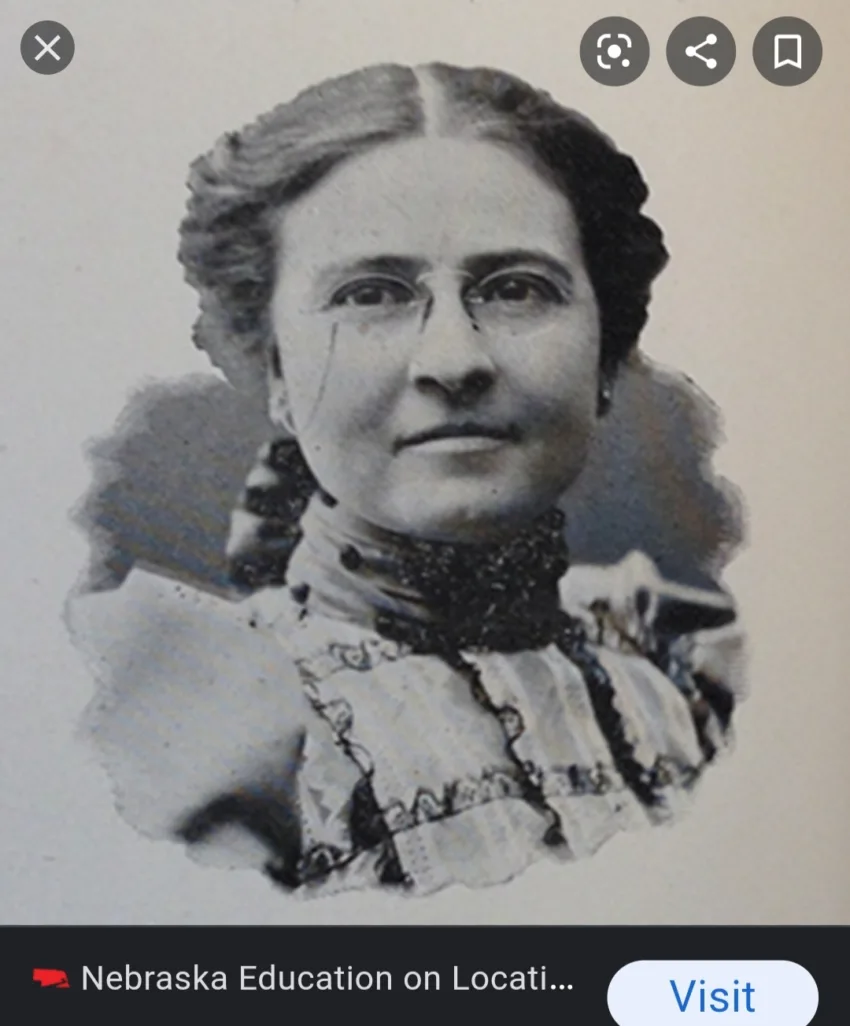1199: Susette la Flesche Tibbles
Omaha Native American Author and Activist
Born: 1854 AD, Omaha Reservation (Present-day Bellevue, Nebraska, United States of America)
Died: 26 May 1903 AD, Omaha Reservation (Present-day Bancroft, Nebraska, United States of America)
Omaha Name: Inshata Theumba (or “Bright Eyes” in English)
“It’s all a farce when you say you’re trying to civilize us, then, after we educate ourselves, refuse us positions of responsibility and leave us utterly powerless to help ourselves. Perhaps the only way to make ourselves heard is to appeal to the American public through the press. They might listen.”
Susette was the daughter of the last recognized Chief of the Omaha Native American Tribe, Iron Eyes (also known as Joseph La Flesche). The same year she was born, the Omaha tribe surrendered their ancestral land to the United States government, and moved onto a reservation in what is now Nebraska. Susette’s little sister Susan was born a few years later and grew up to become the first Native American Physician.
Susette and her siblings attended a school on the reservation, where the girls learned to speak and read English, as well as being taught other skills like cooking and sewing. After graduating from the reservation school, Susette’s father sent her to a private girls’ school in New Jersey to further her education. While a senior at the school, the New York Tribune published one of Susette’s essays, essentially launching her professional career as a writer.
After graduation, Susette returned to the reservation, where she taught at the government school for several years. During her time as a teacher, Susette learned of a decision the federal government was making in regard to the Ponca Native American Tribe. Susette’s grandmother had been born to the Ponca tribe, and so the decision, which forced the tribe to move to Indian Territory (in what is present-day Oklahoma), worried Susette greatly.
In 1879, Susette helped the chief of the Ponca tribe, Standing Bear, sue the federal government over the forced movement and re-negging of treaties the Ponca had signed with the government. Susette acted as the chief’s interpreter. After the Ponca had been forcibly moved to Indian Territory, the chief and several other members struggled across hundreds of miles to return to their homeland in Nebraska. When they finally made it home, they were arrested, leading to Chief Standing Bear suing the government.
Standing Bear ended up winning his case. The verdict, which ruled that “An Indian is a person within the meaning of the law of the United States,” meant that Native American people not only had the right to choose wherever they wanted to live (meaning they could not be forced to live on a reservation) but also that they had the same rights as any other person living within the United States as well. Susette’s work to help the Ponca ignited a firestorm inside of her, and she would spend the rest of her life advocating, traveling, speaking, and writing for the cause of Native American civil rights.
Susette’s speaking tours were a first for Native people. She was the first nationally known Native American to partake on a public speaking tour, some of which lasted months at a time and reached as far afield as Scotland. She was fluent in five languages.
Susette was married to a white man who was also an activist for Native American rights. Her wedding dress is now held by the Smithsonian American Women’s History Museum. They had no children. According to Wikipedia, the reason why Susette and her husband waited so many years to marry is because he was married to another woman first, and he and Susette only wed after his first wife passed away.
In 1887, Susette helped pass the Dawes Act. While looked down upon in later generations, at the time, the Daws Act was a landmark win for Native American rights. The Dawes Act was meant to provide land allotments for individual people, instead of a general amount of land for the entire tribe. While in theory this would have been a great idea, in practice it was decidedly less so. Most individuals were given tracts of land that were practically worthless and could not be used to farm or support the individual the land was given to.
In 1891, Susette and her husband traveled to the site of Wounded Knee, to research the genocide and also help survivors. Around this time, she and her husband also became involved in the controversial Ghost Dance movement.
Susette was only forty-nine when she passed away. Her mother and sister Susan outlived her. Susette was eulogized by the United States Senate for all of her advocacy work, and in 1983 she was inducted into the Nebraska Hall of Fame, and in 1994 she was inducted into the National Women’s Hall of Fame.
Badges Earned:
Find a Grave Marked
Located In My Personal Library:
Uppity Women Speak Their Minds by Vicki Leon
A Warrior of Her People: How Susan La Flesche Overcame Racial Inequality to Become America's First Indian Doctor by Joe Starita
Women in American Indian Society by Rayna Green
Sources:
A Warrior of Her People by Joe Starita
https://www.womenshistory.org/education-resources/biographies/susette-la-flesche-tibbles-bright-eyes
https://www.womenofthehall.org/inductee/susette-la-flesche/
https://www.britannica.com/biography/Susette-La-Flesche
https://awpc.cattcenter.iastate.edu/directory/susette-la-flesche-tibbles/
https://womenshistory.si.edu/herstory/activism/object/susette-la-flesches-wedding-dress
https://www.findagrave.com/memorial/54038294/susette_tibbles

